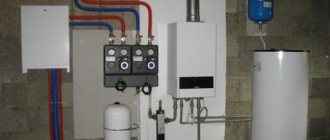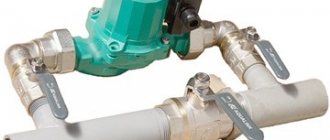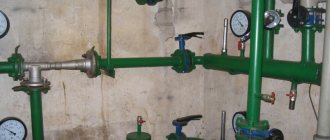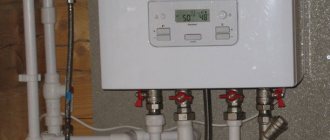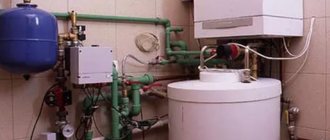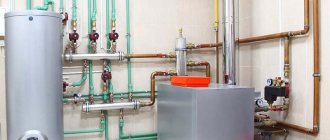What is a double-circuit gas boiler and what is the difference from a single-circuit one?
A double-circuit boiler differs from a single-circuit boiler in the presence of an additional heat exchanger for preparing hot water (it is sometimes called a DHW heat exchanger).
In addition to the main task - heating the coolant for the heating circuit, the procedure for heating and supplying hot water to consumer appliances is performed . This feature makes the boiler more efficient and in demand.
It is noteworthy that no significant changes are made to the design; an additional flow-type heat exchanger is simply installed in the gap in the straight line between the primary heat exchanger and the three-way valve.
The simplicity and small size of the additions make it possible to use the same housings for both types of units, making production more economical. The cost of the boiler increases only by the price of the additional unit.
Which boiler is better to choose
When choosing a unit for heating a private home, they are guided by several criteria.
Take into account the dimensions of the device. In a city apartment, most often there is no space to install an indirect heating boiler and boiler. Therefore, a double-circuit wall model is more suitable. It is inferior in power to single-circuit floor-standing units. But since the apartment usually has a small area, this does not matter.
For a dacha or a private house, if it is possible to organize a separate boiler room, choose a floor-standing single-circuit device and connect the boiler. Moreover, it can have an increased volume. But for a two-story house, it is better to opt for a double-circuit boiler with a large built-in boiler.
Be sure to pay attention to the efficiency of the device. It is different for each model. The higher the efficiency, the better. In areas where there are power outages, you should choose electrically independent boilers. Such models are most often single-circuit.
Device
The main components and parts of double-circuit boilers are:
- gas burner and primary heat exchanger combined with it;
- gas equipment - supply unit, valve, other elements;
- secondary heat exchanger;
- three-way valve;
- turbocharger fan;
- circulation pump;
- expansion tank;
- control board and self-diagnosis sensors.
Boilers created using traditional “open” technology do not have a turbocharging fan, since their smoke removal occurs according to the principle of natural draft, and the air comes directly from the surrounding atmosphere.
Single-circuit boilers
A single-circuit boiler is an installation that provides heating and preparation of the heating circuit coolant in accordance with the specified operating mode of the system.
The design includes:
- Gas burner combined with a heat exchanger.
- Circulation pump.
- Turbofan.
- Gas equipment.
- Three way valve.
- Electronic control board equipped with a self-diagnosis sensor system.
- Housing, control panel.
- Chimney.
There are non-volatile models that do not have devices powered from the mains.
They have a simplified design, but are able to provide heating for the house in the absence of power supply.
Types of single-circuit boilers
There are single-circuit boilers:
- Floor-standing . Installed directly on the floor (or on a stand). They can have a lot of weight and, accordingly, high power. Many floor-standing boilers are equipped with a cast iron heat exchanger of increased efficiency and heavy weight. Some models are connected in a cascade, forming powerful connections for heating buildings or structures of large area and volume.
- Wall mounted . Compact gas boilers that are mounted on solid (preferably load-bearing) walls. The specifics of the installation require a weight limit, which automatically affects the power of the boilers.
In addition, single-circuit boilers can have different combustion chamber options:
- Atmospheric (open) . The air comes directly from the room, and the smoke is removed naturally under the influence of stove-type draft.
- Turbocharged (closed) . Air is taken in from the outside using a turbofan. It also creates pressure that displaces smoke and other gases formed during fuel combustion.
All single-circuit boilers can have additional functions - remote control, programming of operating modes, etc.
Principle of operation
The operation of a single-circuit boiler is aimed at solving a single task - heating the coolant for the heating circuit.
The unit is connected to a gap in the system, one pipe is connected to the direct line, the second to the return line. The liquid flow continuously moves through a heat exchanger, which is located in the heating zone of the gas burner flame.
At the outlet of the heat exchanger, the flow enters a three-way valve, where it is mixed in a given proportion with the colder flow from the return. Having received the required temperature, the coolant is again discharged into the heating circuit.
The temperature is adjusted by adjusting the operation of the three-way valve.
NOTE!
Non-volatile models work on the same principle, only flow circulation occurs naturally.
Advantages and disadvantages
The advantages of single-circuit boilers include:
- Simplicity and reliability of design.
- No power loss during heat transfer.
- Ability to develop greater power.
- Possibility of connecting an external indirect heating boiler to produce hot water.
- The cost of single-circuit boilers is lower than that of more functional models.
The disadvantages of single-circuit boilers should be considered:
- Lack of water heating function.
- Limited capabilities compared to dual-circuit models.
IMPORTANT!
Some users claim that single-circuit boilers in conjunction with an external storage tank are much more convenient and efficient than double-circuit designs.
Operating principle
The operation of a double-circuit boiler consists of two streams:
- The coolant enters the primary heat exchanger and receives the maximum possible temperature. It is then passed through a secondary heat exchanger, where it transfers some of the resulting energy to prepare hot water. After this, it passes into a three-way valve, receives the desired temperature by mixing some of the return flow, and is discharged into the heating circuit for a new circulation circle;
- cold water enters the boiler and is passed through a secondary heat exchanger. After that, it goes to the consumption devices. When the tap opens, water begins to pass through the plate device and heat up in flow mode. The more water is drawn, the lower the water temperature - at high flow rates it does not have time to heat up properly.
The coolant is prepared in the flame of a gas burner. For its operation, air is required, which is supplied by the turbocharger fan. Excess pressure arises, pushing the smoke out through a special coaxial chimney.
The operation of all system components is constantly monitored by self-diagnosis sensors.
They immediately signal the occurrence of failures or malfunctions, the control board places an alert on the display, and in some dangerous situations immediately turns off and locks the boiler.
NOTE!
Non-volatile models are equipped only with mechanical parts. They are much simpler and do not have fans, centrifugal pumps or control units. The functioning of the system occurs on the basis of natural processes of traction and lifting of warm layers of liquid upward.
Construction device
All boilers are equipped with the same components and differ from each other only in a small number of additional elements.
The heating boiler consists of a heat-insulated body, inside of which there are:
- burner;
- heat exchanger;
- automation.
Diagram of a double-circuit gas boiler
The burner in a gas boiler is a chamber for burning fuel (gas), resulting in the release of heat and oxidation products. The main function of the burner is to generate the energy necessary to heat the coolant.
The heat exchanger is located above the burner. The combustion products rising along the walls of the heat exchanger heat the coolant, which then enters the pipes of the heating system. The cooled combustion products are discharged outside through the chimney.
Depending on the type of design of the heat transfer device, the heating boiler can be equipped with a plate (double) or with a bithermic heat exchanger.
- Double heat exchanger design
The first heat exchanger consists of copper plates and pipes. Its main function is to transfer heat to the heating circuit. The second is needed for hot water supply. It consists of plates (hence the name - lamellar), which transfer heat to the heated medium.
- Construction of a bithermic heat exchanger
The heat exchanger is a pipe within a pipe. The inner part of the pipe is used to heat hot water, the outer part is used to heat the room.
The ignition option in gas heating devices is also of no small importance. Thanks to the burner, the fuel burns. Ignition methods: piezo or electric.
Automation controls the operation of all units of the unit. By setting the desired program, you can control the operation of the boiler without personal presence.
Kinds
There are different design options for double-circuit boilers. They can be conditionally united according to specific characteristics.
By installation method:
- wall- mounted Gas boilers that are mounted in a hinged manner on strong, preferably load-bearing walls. The installation method implies the absence of massive and heavy parts. Because of this, the power of wall-mounted boilers does not exceed 35-40 kW;
- floor . They are installed directly on the floor (or on a stand). There are no restrictions on weight and dimensions, so the power of floor-standing boilers can be much greater - up to 100 kW and higher. Also, floor-standing units can be connected in a cascade (usually up to 4 pieces), which allows you to create a powerful heating unit.
By heat exchanger type:
- separate . The design of such boilers has two units - a primary (main) unit in which the coolant is heated, and a secondary unit (usually plate-type, for hot water supply);
- bithermic . This design resembles a coaxial pipe in which coolant flows through the outer cavity, and water for hot water flows through the inner cavity. This design significantly changed the specifics of water heating. The temperature has stabilized, there are no noticeable differences in the DHW supply . However, such a heat exchanger is susceptible to the formation of lime deposits. Flushing does not give noticeable results, and replacing a bithermic heat exchanger is too complicated and expensive.
The material for the heat exchanger can be:
- stainless steel . Used for units of budget units;
- copper . Used in expensive boilers from the most famous manufacturers. They have high performance capabilities and are lightweight, which is important in wall structures;
- ductile cast iron . Heat exchangers of this type are found in floor-standing boilers, where massive parts can be used. The qualities of cast iron make it possible to obtain a high heating effect and equalize temperature changes under harsh operating conditions.
By type of combustion chamber:
- open (atmospheric) . The burner operates on air that comes directly from the room. Smoke removal occurs naturally, using a stove-type draft. To do this, the boiler must be connected to the central chimney. This method is considered outdated and unstable, since it depends on external causes - gusts of wind, drafts, and other factors;
- closed (turbocharged) . The chamber does not communicate with the outside atmosphere, so air is supplied into it using a fan. In this case, excess pressure arises in the chamber, displacing smoke and other combustion gases out. In such designs, a coaxial type chimney is used, the outer pipe of which serves to supply air, and the inner pipe exhausts smoke.
By heat transfer method:
- convection _ Conventional heating of a coil with coolant in a burner flame;
- condensation _ A two-stage heating of the coolant is carried out, preliminary (with heat obtained from condensation of wet smoke) and main (in the usual way). It is necessary to take into account that full operation of such boilers is possible only in low-temperature heating systems - with heated floors, or in regions with high winter temperatures . The critical temperature difference between inside and outside the room at which the process stops is 20°. In Russia this is impossible even in the southern regions.
IMPORTANT!
When choosing a condensing boiler, you should know exactly the principle of its operation and be confident in the possibility of using it in the existing conditions. Otherwise, the money will be wasted.
Boiler manufacturers - which model is better?
It’s easy to get confused in the variety of brands offering their products. How to choose a boiler and not make a mistake with the choice. Currently, the heat and power products market mainly offers equipment from several countries. These are Germany, Italy, Korea and Russia. All boilers have some differences associated with the technical characteristics of their work and also significant differences in cost. German heating boilers.
Bosh boilers have proven themselves for a long time from the best side. Their design is constantly being improved. The boiler is equipped with automation and safety devices that regulate the fuel supply to the burner and are activated in the event of an emergency. To improve heat removal during boiler operation, all heat exchangers are made of copper, which are coated with a special composition to prevent corrosion. The estimated service life of such a boiler is 20 years.
Another German company producing high-class boilers is Viessmann
. They specialize in the production of both single- and double-circuit boilers. Their equipment is characterized by excellent assembly and technical characteristics. According to the stated characteristics, the efficiency of such boilers reaches 93%. In addition, the company's engineers have developed a unique chimney design that prevents condensation of flue gases in the pipe and, as a result, their freezing.
Do you need a boiler?
A double-circuit boiler is capable of independently preparing hot water and does not require additional devices . This is a common view, and it is generally correct.
However, many users are not satisfied with the DHW supply mode in their homes. This usually happens due to a large number of water taps, numerous families, etc. For these cases, there is a way to connect an external drive as a buffer capacity.
Hot water fills the container and is replenished as needed.
The boiler's DHW supply can be adjusted so that the flow rate is minimal . This will ensure high temperatures and stabilize the supply of hot water to consumers.
How does he work
The principle of operation of the boiler is based on heating the coolant, which is located in the heat exchanger. Water is used as a coolant. Depending on the temperature of the water obtained at the outlet, the coolant can maintain the temperature at 35-80 degrees.
Operation of a 2-level boiler
A copper heat exchanger is installed in the boiler above the combustion chamber. The combustion chamber is a metal box, which is covered with heat-insulating material.
When water is supplied to the system, the burner located at the bottom of the chamber lights up. Simultaneously with the burner, the pump starts, forcing the coolant to flow into the heating radiators. As soon as the set temperature is reached, the boiler automation switches it to standby mode, thereby reducing the gas supply.
Considering the fact that water coming from outside is used as a coolant, it contains a high content of manganese and calcium salts.
During operation at high temperatures, the salts present in the water form sediment. It is deposited on the walls and impedes the circulation of the coolant. In the first heat exchanger, water circulates in a closed loop and is therefore less susceptible to contamination. That is why it is advisable to buy boilers with a dual heat exchanger.
In most cases, due to contamination, the second heat exchanger fails, but the boiler continues to operate in heating mode, which is especially important in winter.
A list of other typical gas boiler malfunctions and methods for eliminating them can be found in the material dedicated to self-repair of boilers (go to).
Video
This video clearly demonstrates the heating circuit of a double-circuit gas boiler in two modes.
Summer mode
With the onset of the warm season, the boiler can be switched to summer mode so that only the DHW circuit functions.
In this mode, the operating principle of the device is as follows:
- the heating line is closed by a three-way valve, as a result of which the coolant from the primary heat exchanger begins to flow into the secondary;
- cold water, passing through it, begins to heat up and enters the DHW circuit;
- after this, the burner ignition command is sent automatically and the gas valve opens.
The device will operate in the specified mode until the water is completely heated, and then switches to smooth control mode.
Most popular manufacturers
European companies are considered the most reliable and popular manufacturers.
These include:
- Vaillant;
- Viessmann;
- Navien;
- BAXI;
- Protherm;
- Buderus;
- Bosch, etc.
The list can be continued for a long time, but there is little point in listing the names of companies. on the market, offering their developments and models .
This allows you to choose the most suitable boiler with the required parameters.
How to calculate power?
Calculating boiler power is too complex a task. An unprepared person cannot cope with it . However, there is a simple calculation option that gives an approximate, but quite acceptable result.
Heating 10 m2 of area requires 1 kW of thermal energy. Based on this ratio, you can quickly determine the required boiler power. For example, for a house of 200 sq.m. you need 20 kW of thermal energy.
A unit of either 18 or 24 kW is suitable.
NOTE!
You should not make a large power reserve, since the boiler begins to operate at minimum mode. Frequent starting and stopping of the burner contributes to the rapid failure of components, and scale accumulates in the heat exchanger. The result will be the need for expensive repairs or the purchase of a new boiler.
Rating of TOP 5 double-circuit boilers
Let's consider several popular models of double-circuit boilers:
Buderus Logamax U072-12K
When talking about Buderus boilers, it is necessary to keep in mind that today it is a “daughter” of the world-famous Bosh concern. This determines the general attitude of manufacturers towards their products, the level of requirements and quality.
The brand was built for the production of budget gas boilers, since it is unacceptable for Bosh to reduce the price of its products from a reputational point of view.
The Buderus Logamax U072-12K boiler has a power of 12 kW, which allows it to be used for heating rooms up to 120 sq.m.
The unit is equipped with a copper primary and stainless steel secondary heat exchangers. There is multi-stage protection against freezing, overheating and other undesirable situations.
Main characteristics of the boiler:
- coolant temperature (min-max) - 40-82°;
- temperature in the DHW circuit - 40-65°;
- maximum pressure in the heating system - 3 Bar;
- pressure in the DHW circuit - 8 Bar;
- gas consumption - 2.1 m3/hour;
- dimensions - 400x700x299 mm;
- weight - 29 kg.
The design of the boiler allows it to withstand pressure fluctuations in the gas or water supply system.
It is possible to switch to liquefied gas, which requires a replacement set of gas burner nozzles.
Bosch Gaz 6000 W WBN 6000- 12 C
Double-circuit gas boiler from a world-famous industrial giant. 12 kW of power allows you to heat 120 m2 of area, while simultaneously providing it with hot water .
The unit is equipped with a copper heat exchanger and a stainless secondary component. The volume of the expansion tank is 8 liters, which is quite enough for a 12 kW device.
Basic parameters of the boiler:
- coolant temperature (min-max) - 40-82°;
- temperature in the DHW circuit - 35-60°;
- maximum pressure in the heating system - 3 Bar;
- pressure in the DHW circuit - 10 Bar;
- gas consumption - 2.1 m3/hour;
- dimensions - 400x700x299 mm;
- weight - 28 kg.
Provided that a different set of nozzles is installed, it is possible to reconfigure the boiler to operate on liquefied gas. The permissible butane pressure is 25 mbar, so a reduction reducer is required to connect the cylinder.
Lemax PRIME-V32
The Russian company Lemax is based in Taganrog. The PRIME-V32 boiler is a high-quality double-circuit wall-mounted unit. The design demonstrates high performance.
A separate heat exchanger (primary copper, secondary stainless) ensures efficient heat transfer. The power of the unit is 32 kW, allowing you to heat an area of up to 320 sq.m.
Main characteristics:
- coolant temperature (min-max) - 35-85°
- temperature in the DHW circuit - 40-65°;
- maximum pressure in the heating system - 3 Bar;
- pressure in the DHW circuit - 8 Bar;
- gas consumption - 2.0 m3/hour;
- dimensions - 430x770x340 mm;
- weight - 32 kg.
Lemax boilers differ from other domestic heating products in their approach - most boilers are non-volatile and operate on the principle of a gas stove.
The products of engineers from Taganrog demonstrate a European approach and high performance.
Lemax Premium-30B
This is another example of domestic heating units. Premium-30B is a floor-standing double-circuit boiler with a capacity of 30 kW.
It is suitable for rooms up to 300 sq.m. A massive and heavy unit with an atmospheric burner requires a separate room with its own entrance and window opening.
Main characteristics:
- coolant temperature (min-max) - 40-90°
- temperature in the DHW circuit - 40-70°;
- maximum pressure in the heating system - 3 Bar;
- pressure in the DHW circuit - 6 Bar;
- gas consumption - 3.5 m3/hour;
- dimensions - 556x961x470 mm;
- weight - 88 kg.
Floor-standing boilers are less often produced in a double-circuit version than wall-mounted ones. They are easier to connect to an external water heater, so single-circuit designs are more often offered .
Switching to liquefied gas is possible, but you will need to install a new set of nozzles and reconfigure the boiler parameters.
Navien SMART TOK 24K
The Korean company Navien focuses on the mass buyer, producing affordable boilers in the budget price range. At the same time, the quality of the units is high enough to successfully compete with European models.
The SMART TOK 24K boiler is designed to heat 240 sq. m., which confirms the power of 24 kW. It is equipped with steel heat exchangers and a closed burner.
Options:
- coolant temperature (min-max) - 40-80°
- temperature in the DHW circuit - 30-60°;
- maximum pressure in the heating system - 3 Bar;
- pressure in the DHW circuit - 8 Bar;
- gas consumption - 2.79 m3/hour;
- dimensions - 440x695x290 mm;
- weight - 28 kg.
Many people criticize Korean technology for its high noise level and low strength of some parts.
However, the high demand and demand for boilers from the Korean company show a positive attitude from the majority of buyers.
What is the difference between single-circuit gas boilers and double-circuit gas boilers?
When choosing which is better, a single-circuit or double-circuit boiler, you should thoroughly study the principle of operation, the similarities and differences of each type:
- Single circuit design – high performance. A flow-through coil or “water jacket” made of cast iron or steel is used as a heat exchanger.
- A device with two circuits - a heat exchanger surrounds a coil around the perimeter, connected to a hot water supply system or an indirect heating boiler built into the boiler body.
The difference between a heating boiler with two circuits and a boiler with one circuit lies in its purpose. Models without a built-in 2nd circuit are manufactured exclusively for heating, but with the possibility of additional conversion for hot water supply through an external boiler. Equipment with two circuits, capable of simultaneously working for the heating system and hot water supply.
Which boiler is more profitable - double-circuit or single-circuit?
Comparative gas consumption when operating single-circuit and double-circuit boilers shows that the first models are more economical. But this is valid only under optimal conditions, without taking into account the costs of installing and connecting an indirect heating boiler.
When considering cost-effectiveness, several factors are taken into account:
- Technical characteristics of units with two circuits. For heating equipment, the technical documentation indicates the throughput. This parameter shows how much hot water will be heated per minute. Typically, the coefficient is 10-15 liters for units using instantaneous heating, and 45-60 liters for models with a built-in buffer tank. If this volume is not enough, you will need to install an external storage tank.
- Costs for connecting storage capacity. A boiler costs from 40 to 80% of the cost of a gas heat generator (depending on the chosen model).
- Gas costs – a single-circuit design uses less gas, working exclusively to heat the heating system. After connecting the boiler, additional costs of 10-20% will be required to heat and maintain the temperature of the water in the tank.
Consequently, equipment with one circuit is more economical, but only if you plan to use the selected model of heating equipment strictly for its intended purpose. Connecting a boiler makes its own adjustments and makes the design with two circuits more economical.
Which gas boiler is better to choose - single-circuit or double-circuit
The difference between a single-circuit gas boiler connected to an indirect heating boiler and a 2-circuit one is that the first type of heat generator is not limited by the amount of heated water for domestic hot water. The storage capacity is selected individually, depending on the needs of the residents of the house.
The choice between single-circuit and double-circuit heating boilers is easy to make if you understand well whether and what volume of hot water is required at the output. If DHW is not provided or a large volume of heated water is required, it is better to install a unit with one circuit.
For simultaneous connection to hot water supply and heating system, with a cost of no more than 60 l/min, install a 2-circuit model with a heat exchanger and a coil for domestic hot water.
